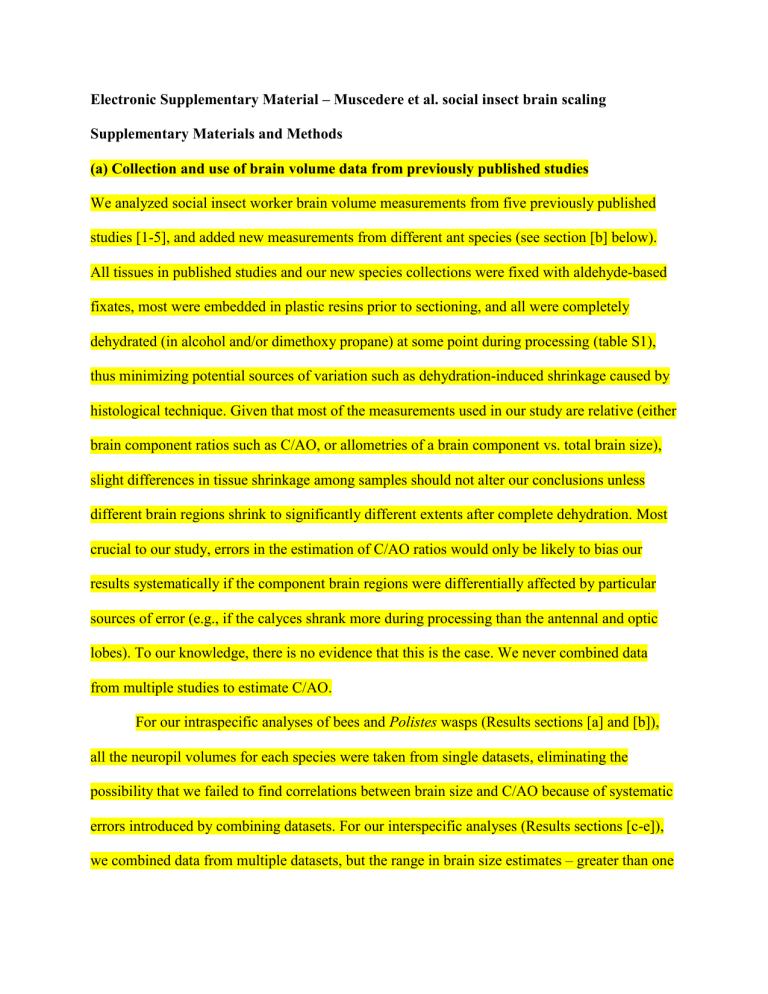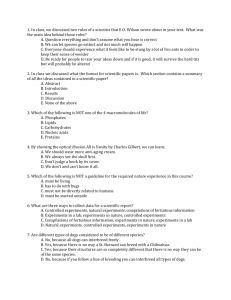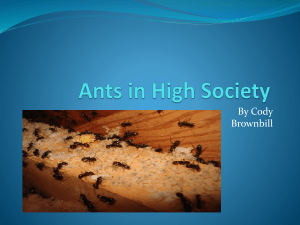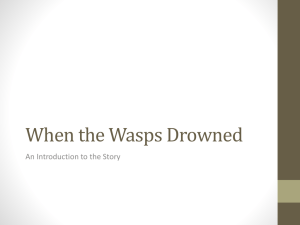Muscedere et al. ESM - Proceedings of the Royal Society B

Electronic Supplementary Material – Muscedere et al. social insect brain scaling
Supplementary Materials and Methods
(a) Collection and use of brain volume data from previously published studies
We analyzed social insect worker brain volume measurements from five previously published studies [1-5], and added new measurements from different ant species (see section [b] below).
All tissues in published studies and our new species collections were fixed with aldehyde-based fixates, most were embedded in plastic resins prior to sectioning, and all were completely dehydrated (in alcohol and/or dimethoxy propane) at some point during processing (table S1), thus minimizing potential sources of variation such as dehydration-induced shrinkage caused by histological technique. Given that most of the measurements used in our study are relative (either brain component ratios such as C/AO, or allometries of a brain component vs. total brain size), slight differences in tissue shrinkage among samples should not alter our conclusions unless different brain regions shrink to significantly different extents after complete dehydration. Most crucial to our study, errors in the estimation of C/AO ratios would only be likely to bias our results systematically if the component brain regions were differentially affected by particular sources of error (e.g., if the calyces shrank more during processing than the antennal and optic lobes). To our knowledge, there is no evidence that this is the case. We never combined data from multiple studies to estimate C/AO.
For our intraspecific analyses of bees and Polistes wasps (Results sections [a] and [b]), all the neuropil volumes for each species were taken from single datasets, eliminating the possibility that we failed to find correlations between brain size and C/AO because of systematic errors introduced by combining datasets. For our interspecific analyses (Results sections [c-e]), we combined data from multiple datasets, but the range in brain size estimates – greater than one
order of magnitude in our ant sample (Results sections [c] and [e]), and greater than two orders of magnitude in our ant, wasp, and honey bee sample (Results section [d]) – suggests that these analyses are robust to any potential small errors introduced by different histological techniques used to generate the data.
(b) Ant brain immunohistochemistry, quantitative brain measures, and eye scaling data collected for this study
Ant workers were taken from queenright, lab-maintained colonies collected in Alachua Co., FL in 2010 ( Pheidole moerens, n = 3 minor workers) and Chestnut Hill, MA in 2011 ( Tapinoma sessile and Brachymyrmex depilis, n = 4 workers per species), or were collected individually in
Chestnut Hill, MA in 2011 and dissected shortly thereafter ( Stigmatomma [= Ambylopone ] pallipes, n = 4 workers). Individual brains were dissected and immunohistochemically stained using the protocol of Wu and Luo [6], with the following modifications: (1) after 4% formaldehyde fixation, brains were dehydrated, stored in absolute methanol at rehydrated just prior to immunostaining; (2) the concentration of Triton-X 100 was increased to
0.4% in our PBT buffer; (3) to visualize regions of neuropil, brains were stained with the primary antibody SYNORF1 (1:50, obtained from the Developmental Studies Hybridoma Bank developed under the auspices of the NICHD and maintained by The University of Iowa,
Department of Biology, Iowa City, IA 52242), and an Alexa Fluor 488 goat-anti mouse secondary antibody (Invitrogen; 1:200); and (4) to visualize cell body regions, we added the nuclear marker TO-PRO-3 (Invitrogen; 1:500) to the penultimate wash. After staining, brains were whole mounted in methyl salicylate and optically sectioned with an Olympus BX50 confocal microscope with a 20x air or 40x water immersion objective. Total brain neuropil
volumes and the volumes of individual brain compartments (the neuropil of the optic lobe [OL], antennal lobe [AL], mushroom body calyces [C], mushroom body peduncle and lobes, and central body, as well as the Kenyon cell body region) were then digitally measured from one hemisphere of each sample using published methods [7]. For 20x micrographs, z-axis scaling artifacts in our confocal image stacks induced by refractive index mismatch were corrected using published scaling factors [8], as described in previous studies [7]. For 40x micrographs, we imaged each brain twice (once with each objective), corrected the 20x image stacks as described above, then empirically derived the scaling factor for our 40x micrographs such that the maximal dorso-ventral height of each brain was equivalent between the 20x and 40x images. To record ommatidia number, we counted the number of ommatidia per eye either from online digital micrographs of specimens from AntWeb ( T. sessile , CASENT0104535; B. depilis ,
CASENT0106038; www.antweb.org), or from our own samples microscopically using epifluorescence illumination of the eye surface ( S. pallipes and P. moerens ).
(b) Wasp brain measurement corrections
Prior to the analyses reported here, we observed that the brain component volumes reported for polistine wasps [4] were orders of magnitude below plausible levels. We assumed that this discrepancy was due to a simple factor-of-ten scaling error introduced while converting
2 2 3
). Scaling the published values by 10
5
yielded volumes appearing to be more accurate (larger than ant brain volumes but lower than honey bee/bumblebee volumes, and corresponding to the order of magnitude of paper wasp brains we have previously studied [5]). We validated this correction by comparing the putatively misscaled values reported for the volume of the C in the wasp Mischocyttarus mastigophorus (ca.
10
2.74
= 550 μm
3
= 5.50 x 10
-7
mm
3
per brain, Figure 3, top panel in [4]) with previously published values for the same species (ca. 0.020 – 0.025 mm 3 per hemisphere = 4.0 – 5.0 x 10 -2 mm
3
per brain, Figure 3 in [9]). Multiplying the former value by 10
5
yields concordance between the two studies. As a final sensitivity analysis, we tested whether correcting by other values over two orders of magnitude (10 4 , 5 x 10 4 , 5 x 10 5 , and 10 6 ) would have altered the results of our scaling analysis across the social hymenopterans (Fig. 2 C ); PCK volume and C/AO were never significantly correlated ( p > 0.47 in all cases, raw species values of ants, wasps, and honey bees).
Therefore, before analyzing the PCK volume measurements of O’Donnell et al. [4], we scaled
published values by 10
5
.
Table S1.
Summaries of histological protocols used by the sources listed in table S2. For the protocol used to generate additional ant data collected for this study, see Supplemental Materials and Methods section (b) above.
Dataset
Honey bee and bumblebee
(neuropil volumes) [1]
Fixation
4% formaldehyde with 0.1% picric acid
Sectioning resin embedded & microtomed
Staining osmium tetroxide
Honey bee (Kenyon cell somal region volume) [2]
Ants not collected in this study [3]
1% formaldehyde with 2.5% glutaraldehyde
2.5% glutaraldehyde
Neotropical paper wasps [4] glyoxal (Prefer fixative,
Anatech)
North American Polistes wasps [5]
4% formaldehyde cryosectioned cresyl violet resin embedded & microtomed osmium-ethyl gallate resin embedded & microtomed toluidine blue resin embedded & microtomed cresyl violet
Table S2.
Full list of included species, with original source publications for brain volume data.
Clade
Bees
Paper wasps
Ants
Species
Apis mellifera
Bombus impatiens
Aphaenogaster boulderensis
Atta sexdens (small workers)
Brachymyrmex depilis
Camponotus floridanus
Cataglyphis bicolor
Cataulacus sp.
Cerapachys sp.
Ectatomma ruidum
Gigantiops destructor
Harpegnathos sp.
Myrmecia sp.
Myrmecocystus navajo
Mystrium rogeri
Pheidole moerens (minor workers)
Stigmatomma pallipes
Tapinoma sessile
Agelaia xanthopus
Angiopolybia zischkai
Apoica pallens
Charterginus fulvus
Leipomeles dorsata
Mischocyttarus mastigophorus
Nectarinella championi
Polistes dominulus
Polistes flavus
Polistes fuscatus
Polistes instabilis
Polybia dimidiata
Protopolybia exigua
Source
[1] (neuropil volumes); [2] (Kenyon cell body region volume)
[4]
[4]
[5]
[5]
[5]
[4]
[4]
[4]
[3] this study this study this study
[4]
[4]
[4]
[4]
[4]
[1]
[3]
[3] this study
[3]
[3]
[3]
[3]
[3]
[3]
[3]
[3]
[3]
Table S3. Intraspecific brain compartment scaling relationships within Polistes paper wasp species.
Species
Brain region n r p log-log SMA scaling slope (
) of region volume vs. RB
R 2
P. dominulus C 22 0.98 <0.0001 1.07 (0.97, 1.17) 0.96
P. flavus
P. fuscatus
AL+OL 22 0.98 <0.0001
AL 22 0.89 <0.0001
OL 22 0.98 <0.0001
C 19 0.69 0.001
AL+OL 19 0.93 <0.0001
AL 19 0.57 0.01
OL 19 0.91 <0.0001
C 22 0.78 <0.0001
AL+OL 22 0.94 <0.0001
AL 22 0.78 <0.0001
OL 22 0.91 <0.0001
0.80 (0.73, 0.87)
1.11 (0.90, 1.37)
0.78 (0.71, 0.85)
1.12 (0.78, 1.60)
1.08 (0.89, 1.30)
2.01 (1.39, 3.15)
1.03 (0.84, 1.27)
1.95 (1.46, 2.59)
1.17 (0.99, 1.37)
1.67 (1.25, 2.23)
1.12 (0.92, 1.36)
0.97
0.80
0.96
0.48
0.86
0.32
0.83
0.62
0.87
0.61
0.82
All data were ln-transformed before analysis. Slopes in bold have 95% confidence intervals that do not include 1.0 (isometry).
Table S4. Summary of analyses of C/AO scaling with brain size within and across social hymenopteran species. “All ants” refers to the entire sample of 16 ant species in our analysis, including data from 4 species collected in this study and 12 species from ref [3]. “PCK ants” refers only to the 4 species collected in this study, for which the brain size metric PCK was available. “O’Donnell wasps” refers to 10 Neotropical polistine wasps previously analyzed by
O’Donnell et al. [4]. For intraspecific analyses, n refers to the number of individual worker brains. For interspecific analyses, n refers to the number of species (or the number of phylogenetically independent contrasts between taxa, which will always be one less than the number of species included). taxon brain size metric figure
Intraspecific analyses
Polistes dominulus RB
Polistes flavus RB
Polistes fuscatus RB
Bombus impatiens
Apis mellifera
RB
RB n r p type of relationship
22 0.56 0.007 positive*
19 -0.32 0.2 n.s.
22 0.28 0.2 n.s.
46 0.04 0.8
25 -0.18 0.4 n.s. n.s.
Interspecific analyses – raw species values all ants RB 16 -0.65 0.007 negative figure 2a
O’Donnell wasps + PCK ants
PCK 14 -0.20 0.5 n.s.
O’Donnell wasps + honey bee PCK 11 0.47 0.1
O’Donnell wasps + PCK ants + honey bee
PCK 15 -0.26 0.4 n.s. n.s. figure 2c
Interspecific analyses – phylogenetically independent contrasts all ants RB 15 -0.70 0.002 negative figure 2b
O’Donnell wasps + PCK ants PCK 13 0.50 0.07 n.s.
O’Donnell wasps + honey bee
PCK 10 0.54 0.09
O’Donnell wasps + PCK ants + honey bee PCK 14 0.14 0.6 n.s. n.s. figure 2d
*concordant with predictions of O’Donnell et al. [4].
Table S5. Interspecific brain compartment scaling relationships across sampled ant species.
Brain region n r p
Raw species values
C 16 0.97 <0.0001
AL+OL 16 0.98 <0.0001
AL 16 0.97 <0.0001
OL 15 0.91 <0.0001 log-log SMA scaling slope (
) of region volume vs. RB
0.94 (0.82, 1.07)
1.19 (1.07, 1.32)
1.01 (0.89, 1.16)
1.56 (1.21, 2.00)
R 2
0.95
0.97
0.95
0.82
Phylogenetically independent contrasts
C 15 0.98 <0.0001
AL+OL 15 0.99 <0.0001
AL 15 0.97 <0.0001
OL 14 0.92 <0.0001
1.06 (0.94, 1.19)
1.16 (1.06, 1.28)
1.03 (0.90, 1.19)
1.46 (1.16, 1.84)
0.96
0.97
0.94
0.85
All data were ln-transformed before analysis. Slopes in bold have 95% confidence intervals that do not include 1.0 (isometry). SMA regression lines were constrained through the origin for PIC analyses.
Apis
Polistes
Mischocyttarus
Apoica
Agelaia
Angiopolybia
Leipomeles
Nectarinella
Protopolybia
Charterginus
Polybia
Harpegnathos
Mystrium
Stigmatomma
Cerapachys
Myrmecia
Tapinoma
Ectatomma
Aphaenogaster
Cataulacus
Atta
Pheidole
Brachymyrmex
Camponotus
Cataglyphis
Gigantiops
Myrmecocystus
Bees
Paper wasps
Ponerinae
Amblyoponinae
Cerapachyinae
Myrmeciinae
Dolichoderinae
Ectatomminae
Myrmicinae
Formicinae
Ants
Figure S1 . Phylogeny of the aculeate eusocial hymenopteran genera included in our comparative analyses (after [10-12]). One additional bee species (the bumblebee Bombus impatiens ) was analyzed only intraspecifically.
Supplementary References
1. Mares S, Ash L, Gronenberg W. 2005 Brain allometry in bumblebee and honey bee
2. workers. Brain Behav. Evol.
66 , 50-61. (doi: 10.1159/000085047).
Withers GS, Fahrbach SE, Robinson GE. 1995 Effects of experience and juvenile
3. hormone on the organization of the mushroom bodies of honey bees. J. Neurobiol.
26 ,
130-144. (doi: 10.1002/neu.480260111).
Gronenberg W, Hölldobler B. 1999 Morphologic representation of visual and antennal information in the ant brain. J. Comp. Neurol.
412 , 229-240. (doi: 10.1002/(SICI)1096-
9861(19990920)412:2<229::AID-CNE4>3.0.CO;2-E).
4.
5.
6.
7.
O'Donnell S, Clifford M, Molina Y. 2011 Comparative analysis of constraints and caste differences in brain investment among social paper wasps. Proc. Natl. Acad. Sci. USA
108 , 7107-7112. (doi: 10.1073/pnas.1017566108).
Gronenberg W, Ash LE, Tibbetts EA. 2007 Correlation between facial pattern recognition and brain composition in paper wasps. Brain Behav. Evol.
71 , 1-14. (doi:
10.1159/00010860).
Wu JS, Juo L. 2006 A protocol for dissecting Drosophila melanogaster brains for live imaging or immunostaining. Nat. Protoc.
1 , 2110-2115. (doi: 10.1038/nprot.2006.336).
Muscedere ML, Traniello JFA. 2012 Division of labor in the hyperdiverse ant genus
Pheidole is associated with distinct subcaste- and age-related patterns of worker brain organization. PLoS ONE 7 , e31618. (doi: 10.1371/journal.pone.0031618).
8. Bucher D, Scholz M, Stetter M, Obermayer K, Pfluger HJ. 2000 Correction methods for three-dimensional reconstructions from confocal images: I. tissue shrinking and axial scaling. J. Neurosci. Methods 100 , 135–143.
9. O'Donnell S, Donlan N, Jones T. 2007 Developmental and dominance-associated differences in mushroom body structure in the paper wasp Mischocyttarus mastigophorus . Dev. Neurobiol.
67 , 39-46. (doi: 10.1002/dneu.20324).
10. Wenzel JW, Carpenter JM. 1994 Comparing methods: adaptive traits and tests of adaptation. In Phylogenetics and Ecology (eds. Eggleton P, Vane-Wright RI), pp. 79-101.
London, Academic.
11. Astruc C, Julien JF, Errard C, Lenoir A. 2004 Phylogeny of ants (Formicidae) based on morphology and DNA sequence data. Mo.l Phylogenet. Evol.
31 , 880-893. (doi:
10.1016/j.ympev.2003.10.024).
12. Moreau CS, Bell CD. 2013 Testing the museum versus cradle tropical biological diversity hypothesis: phylogeny, diversification, and ancestral biogeographic range evolution of the ants. Evolution 67 , 2240-2257. (doi: 10.1111/evo.12105).






